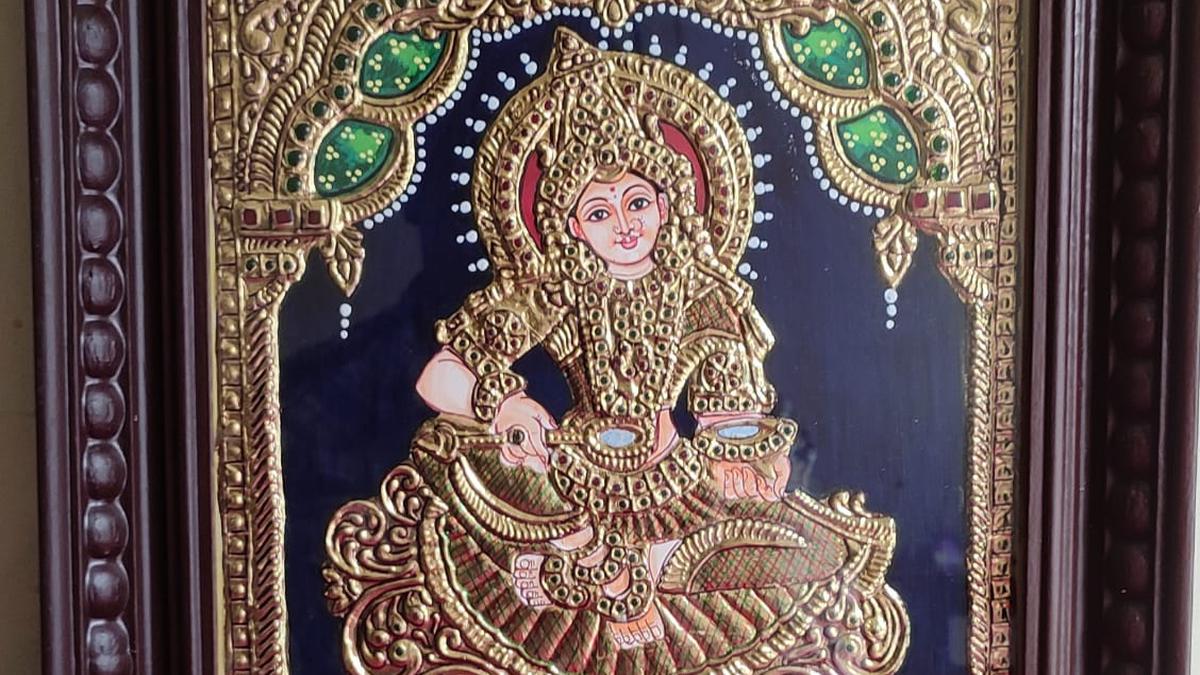
Tanjore painting exhibition in Kochi showcases Chola era art heritage
The Hindu
Treasure Tanjore paintings for their invaluable heritage & craftsmanship, showcased in an exhibition in Kochi till Dec 17.
“A Tanjore painting has to be treasured, not just because it contains gold, but also because of its invaluable heritage,” says Bharani Elangovan, a Tanjore painting artist. “The artform traces its history back to the time of the Chola empire in the 16th century. Carrying forward the tradition is an honour.”
Bharani is part of a Tanjore painting exhibition organised by the Kerala Lalithakala Akademi and South Zone Cultural Centre, Thanjavur, at the Durbar Hall Art Gallery in Kochi.
Along with four other artists, Bharani has been engaging with visitors at the gallery, explaining the history and craft of Tanjore paintings. Her husband, artist K Elangovan, is also part of the team.
Joining the conversation, Bharani’s sister Bharathi Senthilvelan highlights that Tanjore paintings mostly feature Gods, Goddesses and divine beings. “Some artists experiment with modern themes too,” she adds. “However, raw materials have changed over time. In the ancient period, artists used actual precious stones and gold, and the works were framed in teak. Today, instead of diamonds and sapphires, artists use semi-precious stones such as kundan stones and American diamonds,” she explains.
Tanjore paintings often go beyond the realm of art. “They are revered,” says Bharathi, who has displayed a series of acrylic on canvas works inspired by Tanjore paintings.. “Most Hindu prayer rooms in South India would have a Tanjore painting.”
The journey of a Tanjore painting is fascinating, say the artists. “It takes about 20 days to complete a standard-size painting of about 15’’x12’’ proportions,” says Vasudevan A, an artist who hails from Salem. “The first step is preparing the plywood base. The process takes three to four days. The artist then traces the painting and applies muck paste, a mixture of chalk powder and Arabic gum. This is done in order to give the painting a 3D effect. It is then inlaid with stones and gold foil, on which the artist employs the necessary filigree work. The painting is completed in poster colours. “
Bharani chips in that, even today, 22 and 24 karat gold foils are used to embellish the paintings.

Hampi, the UNESCO-recognised historical site, was the capital of the Vijayanagara empire from 1336 to 1565. Foreign travellers from Persia, Europe and other parts of the world have chronicled the wealth of the place and the unique cultural mores of this kingdom built on the banks of the Tungabhadra river. There are fine descriptions to be found of its temples, farms, markets and trading links, remnants of which one can see in the ruins now. The Literature, architecture of this era continue inspire awe.

Unfurling the zine handed to us at the start of the walk, we use brightly-coloured markers to draw squiggly cables across the page, starting from a sepia-toned vintage photograph of the telegraph office. Iz, who goes by the pronouns they/them, explains, “This building is still standing, though it shut down in 2013,” they say, pointing out that telegraphy, which started in Bengaluru in 1854, was an instrument of colonial power and control. “The British colonised lands via telegraph cables, something known as the All Red Line.”

The festival in Bengaluru is happening at various locations, including ATREE in Jakkur, Bangalore Creative Circus in Yeshwantpur, Courtyard Koota in Kengeri, and Medai the Stage in Koramangala. The festival will also take place in various cities across Karnataka including Tumakuru, Ramanagara, Mandya, Kolar, Chikkaballapura, Hassan, Chitradurga, Davangere, Chamarajanagar and Mysuru.








